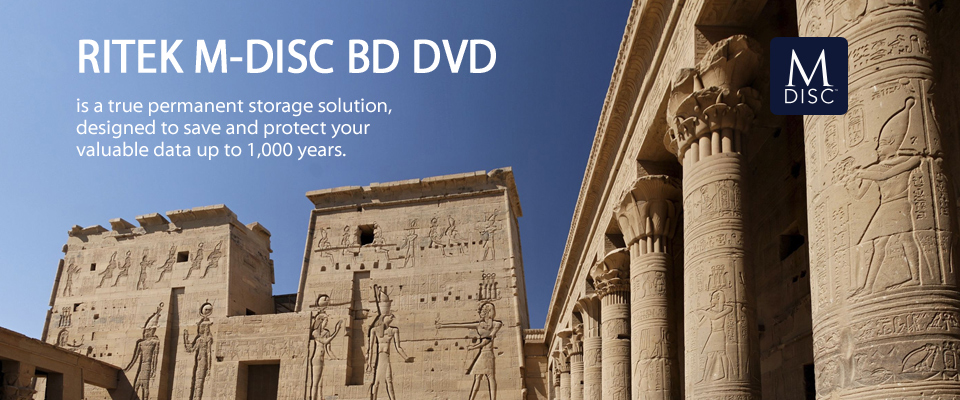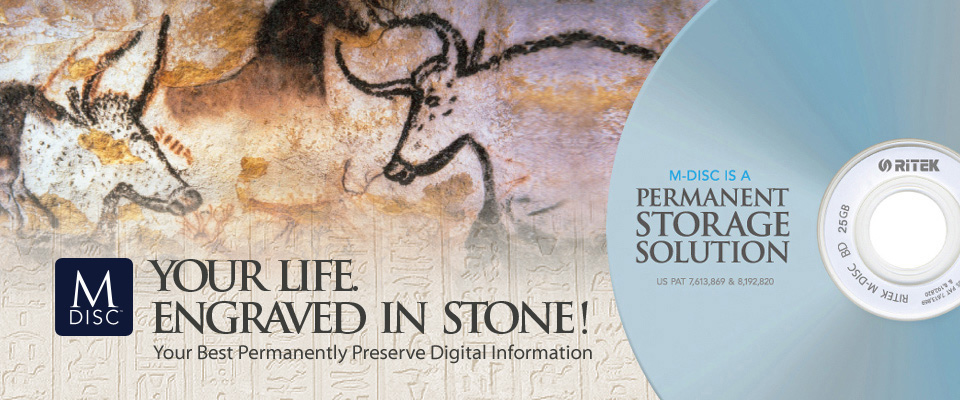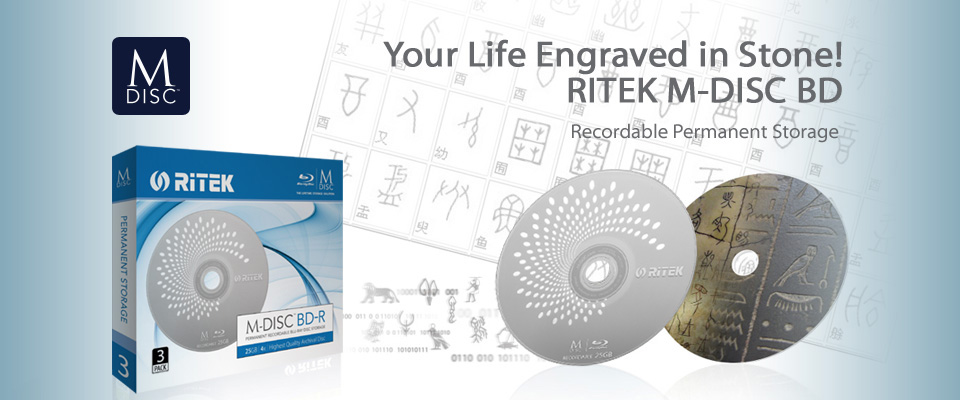 |
 |
 |
 |
 |
 |





|
||
What is an M-DISC READY™ Drive? An M-DISC READY™ Drive is a drive that will burn data to the M-DISC™. Most LG drives are now M-DISC READY™. Currently, the only aftermarket drives (both DVD & BD/DVD types) available are manufactured by LG, however, both ACER & DELL computers are offering M-DISC™ support in some of their PC models. Additional aftermarket drives and PC models are expected to become available from more manufacturers later in 2013.
Can the M-DISC™ be read by regular drives?
RITEK M-DISC BD can be read by most existing BD drives or players.
RITEK M-DISC DVD can be read by most existing BD and DVD drives or players. Can the M-DISC™ be burned or written to by regular drives?
RITEK M-DISC BD can be burned by almost general writers.
RITEK M-DISC DVD requires to be burned by an M-DISC READY Drive, which like LG writers, Please look for drives with these icons :  For more drives’ information, please visit http://www.mdisc.com/m-ready/ Is the M-DISC™ and the M-DISC READY™ Drive compatible with both Mac Computers and PCs?
Yes, The M-DISC READY™ Drive is compatible with both Mac computers and PCs. In fact, our products will work with most operating systems as long as your computer has up-to-date optical drive software and supports the drive interface, typically USB or SATA. Windows and the Mac OS X operating systems provide DVD drive software support, including the ability to engrave data onto the M-DISC™. The reason why some drives, especially Blu-ray drives, may be described by the manufacturer as PC only is because the bundled software included with the drive is PC only, not because of a basic hardware incompatibility. If the optical disc drive you want to purchase is described as PC only, it can typically be used on a Mac, but you may have to buy a separate 3rd-party disc burning software package. Two software packages that are well accepted for Max OS X are Final Cut Pro and Roxio Toast Titanium.
How quickly can M-DISC READY™ Drive burn information to an M-DISC™?
Typical writing speeds for DVDs range from 4x to 24x. The M-DISC™ can be written at 4x speed.
How is the M-DISC READY™ Drive different from a regular DVD writer?
The M-DISC READY™ Drive is different from regular DVD writers because it is designed to make permanent physical changes (etching) to the rock-like data layer of the M-DISC™.
Can I erase or remove files from the M-DISC™?
No. The M-DISC™ is designed to permanently archive information. Once the information is burned it cannot be changed.
Can I add additional files to an M-DISC™ after it has been burned?
Some burning software applications allow for adding additional files to the disc if it has not been closed (sometimes referred to as finalizing or fixing the disc). Refer to your burning software documentation for more information about this. This multi-session capability may or may not be turned on by default in your software.
What burning software is compatible with the M-DISC READY™ Drive?
Almost any DVD burning software will work with the M-DISC READY™ Drive. In fact, current operating systems (Windows 8, Mac OS X) come with compatible software pre-installed and will recognize the M-DISC READY™ Drive automatically. Additionally, the M-DISC READY™ Drive works with most common third party software. Some older operating systems such as Windows XP may require third-party software.
How can you prove that the M-DISC™ will last for centuries?
There are international standards for estimating the archival lifetime of optical media. The ECMA-379 (2nd edition, December 2008) is a widely recognized standard that tests the effects of temperature and relative humidity. Researchers at Millenniata have tested the M-DISC™ using the ECMA-379 temperature and humidity (85°C / 85% RH) and added further elements to develop the most rigorous testing possible. They have combined temperature and humidity (85°C / 85% RH) tests with exposure to the full-spectrum of natural light. The M-DISC™ is the only survivor after this rigorous testing. Considering the combination of the M-DISC™’s test results and its rock-like data layer, it is reasonable to conclude that the M-DISC™ has a greater longevity and durability than competitors’ discs.
The M-DISC™ may be around for centuries, but why would that matter if DVD players were not around that long?
Every storage technology faces the same question. The M-DISC™ is unique because it provides options that didn’t exist before. The stability of the M-DISC™ allows people to migrate data at their own convenience. This is in contrast to today’s storage technology that incessantly forces a constant and expensive physical rotation of stored data—trying to rotate the data before the media’s expiration date. This frustrating and costly challenge disappears with the M-DISC™. No longer will people be forced to rotate data onto a new storage medium because of data rot. Whether it is 10 years or 20 years down the road, your information will be safely etched on the M-DISC™.
What temperature can the M-DISC™ withstand?
The M-DISC™ can withstand temperatures of 176°F (80°C) for days with no effect to the data or the readability of the data in a standard DVD drive. In order to maximize archival lifetime, it is not recommended that an M-DISC™ be stored under these conditions.
Can the M-DISC™ withstand UV rays and prolonged exposure to the sun?
M-DISC™ products can withstand the full spectrum of the sun, including UV rays, for days with no effect to the data or the readability of the data in a standard DVD drive. In order to maximize archival lifetime, it is not recommended that M-DISC™ products be stored under these conditions.
How do I store M-DISC™ products to extend their useful life?
The M-DISC™ is extremely durable and does not corrupt even in extreme environmental conditions (heat, humidity, light, etc.). However, we suggest storing M-DISC™ products upright in plastic or steel containers manufactured specifically for the type of medium in cool, dry storage that is free of large temperature fluctuations.
Burning power increase of 5%, will affect the disc player life ?
The laser diode powers we require to burn the M-Disc DVD are less than the power required to burn a regular DVD at 16X speed, so the diode power is well within the capability of the standard hardware. What is true is that the laser power used to burn an M-Disc DVD at 4X is higher than that used for a typical DVD at 4X, but most DVD’s now burn at higher speeds, so the actual power levels used in burning a disc are not that different. The read power is not significantly different from that used for any other DVD. It is true that the Laser Diode is typically the first failure point in a drive, and that a drive that experiences a lot of high power usage will fail faster, but the M-Disc is not the highest-power use that is common with a DVD drive.
What is ISO/IEC 10995 ? ISO is an acronym for the International Organization for Standardization, which is the world’s largest developer of voluntary international standards (see www.iso.org). Among many other purposes, ISO Standards help ensure that products and services are safe, reliable, and of good quality, and they help avoid product performance claims that are based on misleading or fake tests and junk science. The ISO/IEC 10995 standard was developed to provide a scientific basis for determining the reliability of optical media, and for DVD in particular. The first edition of the standard was released in 2008 and the standard was updated in 2011. You can find further information on this standard on the ISO website by searching under ISO/IEC 10995:2011. The ISO/IEC 10995 Standard defines a rigorous set of tests using high heat and high humidity. Testing DVD’s under these conditions requires at least 8 months of continuous testing and considerable expense in order to obtain the data necessary to scientifically estimate lifetime. One of the many indications that M-Disc is SERIOUS about preserving data permanently is that we have gone through the time and the expense to evaluate the M-Disc to this internationally recognized standard. What is the test method ? The Eyring test method (and the simpler, but closely related Arrhenius test method) is based on a powerful theory in Chemistry that relates the rate of chemical reactions to temperature. By determining how the rates of the chemical reactions that cause aging vary with temperature, it is possible to estimate the lifetime of a variety of products. The Eyring method is commonly used to test automobile parts, integrated circuits and other electronics, paint, and many other kinds of products besides DVDs. Following the Eyring method, the ISO/IEC 10995 test defines for test conditions of heat and humidity. These conditions are: 85°C and 85% Relative Humidity (RH); 85°C and 70% RH;, 75°C and 75% RH, 65°C and 85%RH. At least 20 discs are tested under each of these conditions for up to 2500 hours or until they fail. The data obtained during these tests is then mathematically analyzed according to the Eyring Theory to determine the expected lifetime at room temperature storage conditions, which is defined at 25 °C and 50% RH. <Test results> M-Disc Vs. Silver Alloy & Gold Discs ?
Fact 1: What makes M-Disc better than other archival discs?
M-Discs utilize a proprietary rock-like inorganic material that engraves data instead of using reflectivity on organic materials that will eventually break apart and decompose with time. Furthermore, did you know that M-Disc technology is already being adopted worldwide by all major drive manufacturers, and that the M-Disc Blu-ray is read/write compatible with all current Blu-ray RW drives? While is important to note that gold has a lower reflectivity than silver, even silver discs are still made of organic materials that may begin to lose data after only 2 years. Fact 2: What should you know about organic dye decomposition? Once an organic dye decomposes, data is impossible to recover. The reflective layer and the organic dye layer are the two most parts of today’s gold & silver archival discs. The most silver discs can do is prolong the inevitable decomposition of their organic dye layer by including a special in-house additive that can only marginally minimize the organic decomposition of their discs. Fact 3: How should you measure quality in archival grade discs? This is a difficult question because even the best silver & gold archival discs are still composed of organic materials that can begin to decompose and deteriorate (causing irreversible data loss). Many companies claim a strict manufacturing process and Quality Control to ensure quality and reliability, but this does not change the fact that the materials that make up the discs are unreliable at best for permanent storage even under normal conditions. Are M-Discs in the Blu-ray & DVD family ?
M-Disc technology is fast becoming a standard in the optical industry. All Blu-ray RW drives can engrave data onto the M-Disc Blu-ray. In addition, all major drive manufacturers such as LG, HLDS, TSST, PLDS, and Panasonic have already begun making their drives compatible with M-Disc.
|
| © RITEK Corporation. All Rights Reserved. Website is partly referred from www.mdisc.com |



